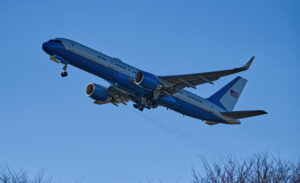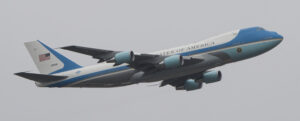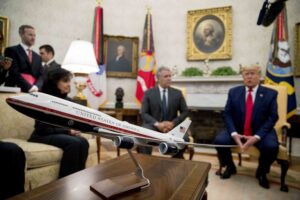For the last few years Aerospace Perceptions – based in New Castle, Delaware and just a few roads away from the Wilmington home of President Biden – has enjoyed many, many flights of Air Force One in the guise of C-32 airframes, a military aircraft based on the Boeing 757-200.

C-32/Air Force One lifts off from ILG in New Castle, Delaware, on November 11, 2024. Photo: Frank Moriarty/Aerospace Perceptions
And the larger VC-25A – the aircraft the public generally envisions as “Air Force One” – has operated frequently in and out of the nearby Philadelphia International Airport and Dover Air Force Base locations, the big jet being prohibited from landing at New Castle’s airport due to runway requirements.

VC-25A/Air Force One on final approach into Philadelphia International Airport, October 26, 2024. Photo: Frank Moriarty/Aerospace Perceptions
But now, as the Biden presidency enters its final weeks, change will also be coming to the VC-25, in the form of the long-anticipated VC-25B. It’s been some time since Air Force One has been a topic here, so it is time for an update.
The two “A” aircraft – 82-8000 and 92-9000 – have served presidents for three decades, so it’s not a surprise that it is time for a newer “B” series to replace them. But the planned inception of the new aircraft has been pushed back repeatedly. Initial plans called for the VC-25B to enter service as soon as 2017, then was dialed in for 2024, and now is pushed even further back to 2027 for the first of the two aircraft, 2028 for the second.

VC-25A/Air Force One takes off from Philadelphia International Airport on March 9, 2024. Photo: Frank Moriarty/Aerospace Perceptions
The airframes for the VC-25B are Boeing 747-8I jets, originally earmarked to be part of Russian operator Transaero’s fleet. But before delivery could take place, that line ceased operations, and the aircraft were stored at a facility in the Mojave Desert until being purchased by the United States Air Force. Currently, these two airplanes are at a Boeing facility in Texas, undergoing a metamorphosis from commercial aircraft duty to the status of most highly secure jets in the world.
Of course, specific internal details of these new VC-25B aircraft are not for public consumption. But what will be obvious is the appearance of these jets – although even that aspect may delay the aircrafts’ delivery further.

Artist conception of VC-25B in livery carrying on from the VC-25A series. Image Rendering: United States Air Force
In March 2023, President Biden selected a graceful new livery for the VC-25B that closely mirrored that of the VC-25A, relying heavily on sky blue and white accented with thin gold and white stripes.
The airiness of this VC-25B exterior design stands in stark contrast to the weighty color scheme Donald Trump attempted to specify during his first presidency. Essentially, it is an inversion of the scheme of his private jet known as Trump Force One. He envisioned a white top, red center, and very dark blue bottom. At the time, the USAF demurred, citing a number of concerns, principally heating issues as a result of the dark blue.

A rendering of a new look for Air Force One takes a prominent place in the Oval Office in this photograph from March 2, 2020. Photo: Andrew Harnik for Associated Press
Now, though, with Trump ready to move back into the White House, there is speculation that he will scrap the Biden colors in favor of his own plans. The problem is that, this late in the VC-25B program, the costs of engineering assessments of the new colors and how they may impact temperature interactions and possibly communications aspects could add millions of dollars and even more delays to the VC-25B.
How will it all play out? As legendary NASCAR driver Bill Elliott was frequently heard to say when asked about upcoming races: “We’ll just have to wait and see…”
Meanwhile, while we are waiting, here are three fun facts you may not know about the aircraft all variations of the VC-25 are based upon, the “Queen of the Skies,” the Boeing 747.
- When high-speed prototype tests of the 747 were undertaken in March 1969, an unexpected and disturbing fluttering of the aircraft wings was quickly noticed. The solution? Add dampening weight – in the form of depleted uranium blocks! The first 550 747s built were thus equipped, until 1981 when tungsten became the preferred weight.
- The 747 may be the most-recognized four-engine aircraft, but did you know it can be turned into a five-engine configuration? All 747s before the -8 series had the ability to carry a fifth engine mounted under the wing essentially as cargo on an as-needed basis. Fuel would be added to the opposing wing to ensure proper balance while carrying the extra weight.
- From a fifth engine to a Boeing 747 with just three engines? When competing with the emergence of the tri-engine Douglas DC-10 and Lockheed L-1011 in the 1970s, and before the development of the 747SP, Boeing briefly considered building a tri-engine 747. The aircraft would have shared power configuration with the two Boeing competitors – with an engine mounted under each wing and a third at the base of the tail. But the design was quickly ruled to be impractical from a cost and engineering standpoint, so attention was turned to the SP, a program yielding a “smaller” four-engine 747.
Thanks to Lorenzo Dalla Valentina for covering these details in his fabulous book Boeing 747: Queen of the Skies for 50 Years, certainly one of the best and most detailed aviation books ever printed.







